|
|
|
 |

 |
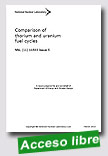 |
Comparison of thorium and uranium fuel cycles
National Nuclear Laboratory (UK), March 2012, 31 p.
The UK National Nuclear Laboratory has been contracted by the Department for Energy and Climate Change (DECC) to review and assess the relevance to the UK of the advanced reactor systems currently being developed internationally. Part of the task specification relates to comparison of the thorium and uranium fuel cycles. Worldwide, there has for a long time been a sustained interest in the thorium fuel cycle and presently there are several major research initiatives which are either focused
|
specifically on the thorium fuel cycle or on systems which use thorium as the fertile seed instead of U-238. Currently in the UK, the thorium fuel cycle is not an option that is being pursued commercially and it is important for DECC to understand why this is the case and whether there is a valid argument for adopting a different position in the future.
Extraído de:
http://www.decc.gov.uk/assets/decc/11/meeting-energy-demand/nuclear/6300-comparison-fuel-cycles.pdf
|
 |
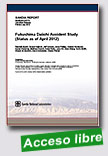 |
Fukushima Daiichi Accident Study (Status as of April 2012)
Sandia National Laboratories, July 2012, 298 p.
Following the earthquake and devastating tsunami last year that damaged the nuclear power complex at Fukushima, Japan, Sandia experts were asked to apply the Labs’ 30-plus years of experience in modeling severe accidents to help reconstruct what happened there.
Sandia analysts say they hope the recently released “Fukushima Daiichi Accident Study” will assist researchers, operators, and regulators in understanding the accident and guide future efforts
|
to improve reactor safety and responses to severe accidents. The work will also be used to validate the MELCOR code (a system-level severe accident analysis code developed by Sandia to help the NRC inform its decision-making process) and the Fukushima models, and suggest potential future data needs for improvements.
The project is a partnership among Sandia, Idaho, and Oak Ridge national laboratories. DOE and the Nuclear Regulatory Commission sponsored the report and have planned follow-up severe accident analyses.
Extraído de:
http://www.sandia.gov/news/publications/LabNews/archive/12-10-08.html
|
 |
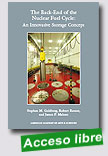 |
The Back-End of the Nuclear Fuel Cycle: An Innovative Storage Concept
American Academy of Arts and Sciences, 2012, 72 p.
A safe nuclear future depends in great measure on how the nuclear fuel cycle is managed. In 2010, the Academy published Multinational Approaches to the Nuclear Fuel Cycle, which considered spent-fuel management in an international context. The present volume draws on that paper but also moves the debate forward. Robert Rosner (University of Chicago), Stephen M. Goldberg (Argonne National Laboratory), and James P. Malone (Lightbridge) outline a concept to transform the existing international nuclear fuel cycle market. Their proposal
|
addresses the economic decisions that businesses and governments need to make as well as the established competition in back-end services. The model reflects and expands on the recommendations in the recent report from the U.S. President’s Blue Ribbon Commission on America’s Nuclear Future.
The leaders of the GNF Initiative are working with decision-makers and stakeholders in nuclear consumer states to advance this new business model. Project leaders will work with international colleagues in South and East Asia to develop regional partnerships for managing used nuclear fuel. These agreements could then serve as a building block for similar arrangements in other regions.
Extraído de:
http://www.amacad.org/pdfs/backend.pdf
|
 |
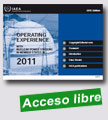 |
This report is the forty-third in the IAEA’s series of annual reports on operating experience with nuclear power stations in Member States. For the seventh time it is issued only in an electronic format.
This report provides annual performance data and outage
|
information for individual nuclear power plants from around the world. Summaries of historical performance and outages during the lifetimes of those plants are also included. Additionally, in order to provide a broad picture of nuclear power usage, this report contains six figures that illustrate global operational statistics through 2011.
The report is a direct output from the IAEA’s Power Reactor Information System (PRIS), whose databank contains all operating experience data published in the IAEA’s operating experience annual reports since 1970 and basic information on power reactors, including design data. It presents operating experience data for all worldwide nuclear power plants after starting commercial operation. The PRIS databank is available free of charge to IAEA Member States through its public web site and on-line application, PRISStatistics.
The web site www.iaea.org/pris contains publicly available information about reactor units and nuclear industry results. The PRIS-Statistics (http://pris.iaea.org) allows direct access to the database through the internet. This application allows registered users to report generation through pre designed reports and filters.
Extraído de:
http://www-pub.iaea.org/MTCD/Publications/PDF/OPEX_2011_CD_web/Start.pdf
|
 |
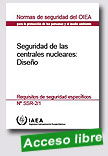 |
Seguridad de las centrales nucleares: Diseño
Colección de normas de seguridad del OIEA, 2012, 99 p.
En la presente publicación se establecen requisitos de diseño para las estructuras, los sistemas y los componentes de una central nuclear, así como para los procedimientos y los procesos organizativos importantes para la seguridad, que deben cumplirse para la explotación con seguridad de la central y para prevenir sucesos que puedan poner en peligro la seguridad, o para mitigar las consecuencias de esos sucesos, si llegaran a producirse.
|
Esta publicación está dirigida a las organizaciones que participan en el diseño, la fabricación, la construcción, la modificación, el mantenimiento, la explotación y la clausura de las centrales nucleares, en el análisis, la verificación y el examen y en la prestación de apoyo técnico, así como a los órganos reguladores.
Extraído de:
http://www-pub.iaea.org/MTCD/Publications/PDF/Pub1534s_web.pdf |
 |
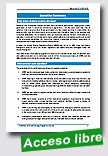 |
Performance Audit on Activities of Atomic Energy Regulatory Board
Comptroller and Auditor General of India, 2012, 91 p.
The objectives of this performance audit were to examine whether: i. AERB has the necessary legal status, authority, independence and adequate mandate to fulfil the responsibilities expected of a nuclear regulator; ii. AERB, keeping in view the international recommendations and local requirements, has been able to develop safety policies in nuclear, radiological and industrial safety areas as well as safety codes, guides and standards for siting, designing,
|
constructing, commissioning, operating and decommissioning different types of nuclear and radiation facilities; iii. AERB has been able to regulate nuclear and other radiation utilities through a system of consents effectively; iv. AERB has ensured compliance of the prescribed regulatory requirements by nuclear power plants, other nuclear facilities and radiation facilities through a system of efficient regulatory inspection and enforcement; v. AERB is monitoring and discharging its responsibilities relating to radiation exposure to occupational workers and members of the public and release of radioactive substances in the environment in an efficient and effective manner.
Extraído de:
http://saiindia.gov.in/english/home/Our_Products/Audit_Report/Government_
Wise/union_audit/recent_reports/union_performance/2012_2013/SD/Report_
9/Exe_Summ.pdf
|
 |
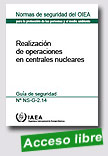
|
Realización de operaciones en centrales nucleares Colección de normas de seguridad del OIEA, 2012, 75 p.
El objetivo de esta publicación es proporcionar a los Estados recomendaciones destinadas a garantizar que las operaciones de una central se llevan a cabo de manera segura, efectiva, minuciosa y profesional, de conformidad con los requisitos establecidos en la Ref. [1] y, en lo posible, las mejores prácticas internacionales. Las recomendaciones de esta Guía de Seguridad facilitan más detalles sobre actividades directas para las operaciones, que complementan la Sección 6 de la Guía de Seguridad sobre The Operating Organization for Nuclear Power Plants. |
Extraído de:
http://www-pub.iaea.org/MTCD/Publications/PDF/Pub1339s_web.pdf
|
 |
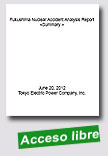 |
Fukushima Nuclear Accident Analysis Report - Summary
Tokyo Electric Power Company (TEPCO), June 20, 2012, 58 p.
The objective of this report is to investigate the causes of the accident at the Fukushima Daiichi Nuclear Power Station (hereinafter referred to as "Fukushima Daiichi") based on the facts known to date and the results of several analyses, and to put forward the necessary measures to contribute to improving the safety at the other existing nuclear power plants.
For these reasons, so as not to be visited by a similar tragedy in the future, we have focused on the issues concerning the |
prevention of core damage, from the perspective of the importance of learning from the events that occurred, to improve operations and facilities.
This report supplements the December 2011 Interim Report with the addition of investigations and examinations carried out after the release of the Interim Report, from the following three perspectives: In addition to the issues concerning and measures taken in regard to the facilities as written in the Interim Report, issues concerning and measures taken in regard to operations have also been added; Items for which investigations had not yet been completed at the time of the release of the Interim Report have been added; and Further investigation was conducted on the issues in question and added to the report.
Extraído de:
http://www.tepco.co.jp/en/press/corp-com/release/betu12_e/images/120620e0102.pdf
|
 |
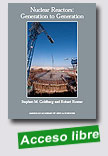 |
Nuclear Reactors: Generation to Generation
American Academy of Arts and Sciences, 2011, 40 p.
Many factors influence the development and deployment of nuclear reactors. In this white paper, we identify six of them: cost-effectiveness, safety, security and nonproliferation features, grid appropriateness, commercialization roadmap (including constructability and licensability), and management of the fuel cycle. We also outline the evolution of nuclear reactor generations and describe current and possible future reactor proposals in light of these six key factors. In our opinion,
|
incorporation of passive safety features and implementation
of dry cask storage for used fuel reasonably address future safety and waste concerns. The nonproliferation benefits of future designs remain unclear, however, and more research will be required. Investment barriers have been overcome in different ways by different countries, but identifying investment priorities and investors will determine, in general, the extent to which
nuclear power remains a viable wedge of the global energy future. Geopolitical factors may tip the scales in favor of a country investing in nuclear energy. These factors include the obvious hedging strategies (i.e., using nuclear power as a hedge against an uncertain natural gas supply and price outlook, as well as an uncertain climate policy), as well as more-subtle strategies, such as using nuclear power to demonstrate technological prowess or as a future bargaining chip in a security context. The lessons from the unfortunate events in Japan were still being assessed when this paper went to press. What is clear, however, is that U.S. leadership is required.
Extraído de:
http://www.amacad.org/pdfs/nuclearReactors.pdf
|
 |
|
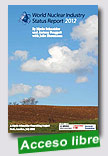
|
The World Nuclear Industry Status Report 2012
Mycle Schneider Consulting, July 2012, 100 p.
Twenty years after its first edition, World Nuclear Industry Status Report 2012 portrays an industry suffering from the cumulative impacts of the world economic crisis, the Fukushima disaster, ferocious competitors and its own planning and management difficulties.
The report provides a global overview of the history, the current status and trends of nuclear power programs in the world. It looks at units in operation and under construction. Annex 1 also provides detailed country-by-country information. A specific chapter assesses the situation in potential newcomer countries. For the first time, the report looks at the credit-rating performance of some of the major nuclear companies and utilities. A more detailed chapter on the development patterns of renewable energies versus nuclear power is also included.
|
|
|
|
|
|
|
|
